Bass guitars usually have a few knobs which can adjust the sound, but what do these controls actually do? In this article, I’ll talk through the main knob layouts, and what all the controls do on popular models. I’ll also give you an quick step-by-step method to figure out exactly what each control does, even if it’s not one of the popular models specifically mentioned.
Bass Controls Quick Guide
All bass guitars have a tone control and usually a volume control. Depending on the bass guitar model, it will either have a master volume control which acts on both pickups, or a volume control for each pickup. Bass guitars usually have between 1 and 5 knobs to adjust the tone or volume.
Depending on the bass guitar you’re using, you will have access to different controls. Here are some of the main knobs you can find on a bass, and what they do. In the next section, I’ll explain how to figure out which knob does what.
- Master Volume: this adjusts how loud the pickup is. If the bass has two volume controls (one for each pickup), you can blend the sound of them by using these pickups and adjusting the balance to affect the tone.
- Tone: on simple layouts, you may see a single tone control. This adjusts the treble frequencies. Decreasing the tone control will make the bass sound less sharp and harsh, and more mellow.
- Blend: on bass guitars with two pickups and only one volume control, you will also usually have a blend control. Rolling it towards the neck will activate the neck pickup only, towards the bridge will active the bridge pickup only, and the central position will equally balance the volume of both pickups. The neck pickup sounds more mellow and the bridge pickup sounds more punchy and crisp.
- Bass: this adjusts the low-end frequencies, and increasing it will cause the bass guitar to sound “boomy”.
- Mids: this adjusts the mid-range frequencies and increasing it will provide more definition to the tone.
- Treble: this adjusts the high-range frequencies. Having it on maximum can cause the bass to sound harsh, whilst turning it down causes it to sound more mellow.
The rest of the article is split into sections outlining the controls on different bass guitars. Here’s the contents:
- One pickup and two controls
- One pickup and three controls
- Two pickups and three controls
- Two pickups and four controls
- Two pickups and five controls
- Three pickups
Note: the pickup number refers to the number of separate pickup positions. Split pickups count as a single pickup.
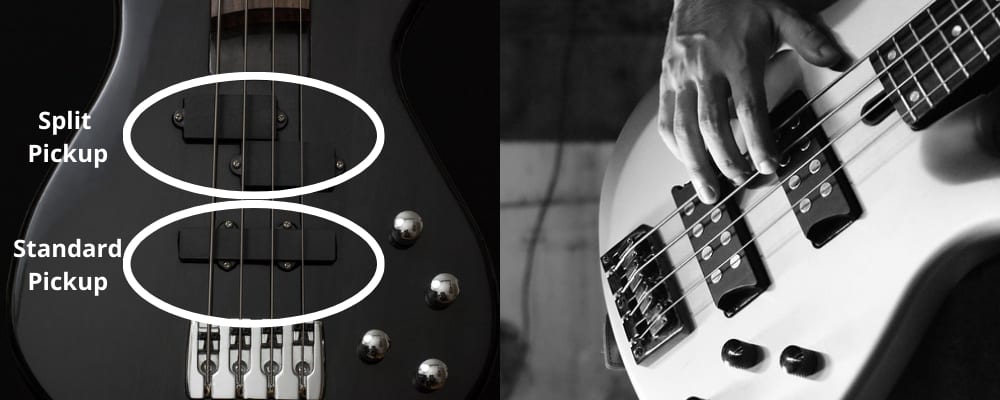
One Pickup and Two Controls
The most simple bass guitar control layout has two knobs, and one pickup. One control will be for the volume of the pickup, and the other is for the tone.
Bass guitars with this layout include:
- Fender/ Squier Precision
- Fender/ Squier Mustang
- G&L Tribute LB-100
- Gibson Les Paul Junior Tribute
- Epiphone EB0 SG
- Schecter Banshee
More often than not, the inner control, will be the master volume, and the outer control will be the master tone, but this is not always the case. You can pretty easily figure it out though:
- Make sure your bass is connected to your amp.
- Turn both controls on your bass guitar off completely.
- Try to play something on your bass and you’ll easily notice which is the volume control, as the tone control on its own will not produce any sound.
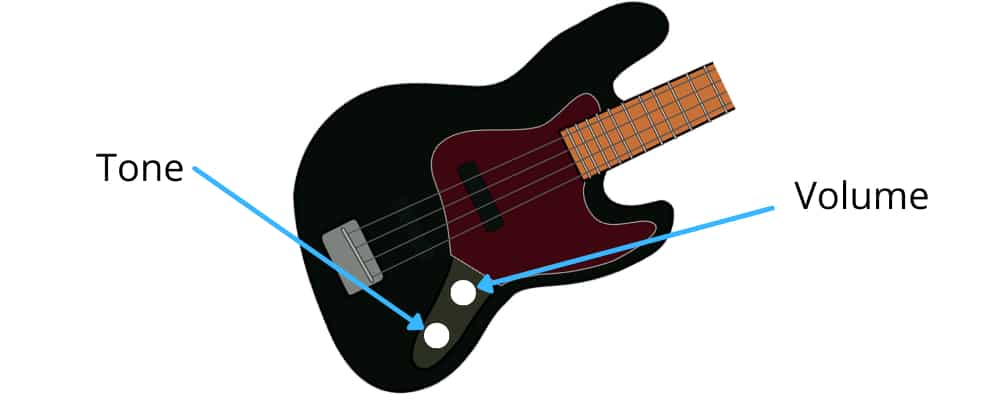
One Pickup and Three Controls
If a bass guitar has one pickup, and three controls, they will usually be master volume, treble and bass knobs. The treble control will be used to adjust the high-end frequencies, whilst the bass control will be used to adjust the low-end frequencies.
You can work out which is the volume control easily, and use this method to figure out which is the bass and which is the treble:
- Make sure your bass is connected to your amp.
- Turn on the volume control on your bass.
- Set the two other controls to maximum.
- Decrease one control and listen to the effect.
- If the tone sounds warmer and less harsh, it is the treble control.
- If the tone sounds less “boomy” it is the bass control.
Usually the inner control will be the bass, and the outer will be the treble, but you can use the method above to check.
Here are some popular bass guitars with this layout:
- Sterling by Music Man Stingray/ Sub Ray
- G&L CLF Research
- Schecter Bass P-4
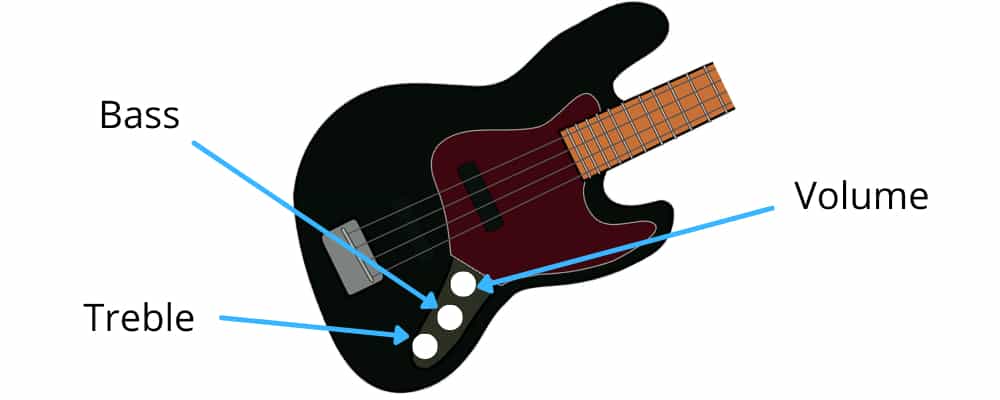
Two Pickups and Three Controls
When a bass guitar has two pickups and three controls, there are two possibilities:
- Volume control for each pickup and a tone control
- Master volume, blend and tone
Both these options allow you to adjust how much of each pickup you are hearing. You can work out which controls your bass has by using the following method:
- Make sure your bass is connected to your amp.
- Turn all the controls on your bass to zero.
- Turn the first control up to see if it is a volume control. You can tap on the pickup very lightly with a screw driver to see if it picks up any sound.
- Repeat this with the other two controls.
- If two of them produce feedback with the screwdriver when the other controls are turned off, then your bass has independent volume controls for each pickup.
- If only one of them produces feedback, then you have a master volume, blend and master tone control.
- You can figure out which is the tone control by setting the other controls to neutral. Turn one of the controls to maximum and tap each pickup lightly using a screw driver. If only one pickup produces sound, then this is the blend control. If both still produce sound, then it is a tone control.
Bass guitars with two pickups, a master volume, master tone and blend control include:
- ESP AP
Bass guitars with two pickups, two volume controls and a tone control include:
- Schecter Sixx
- G&L Tribute JB-2
- Fender American Performer Precision
- Fender/ Squier Jazz
- Fender Player Jaguar
- Jackson JS2 Concert
- Gibson/ Epiphone SG Standard
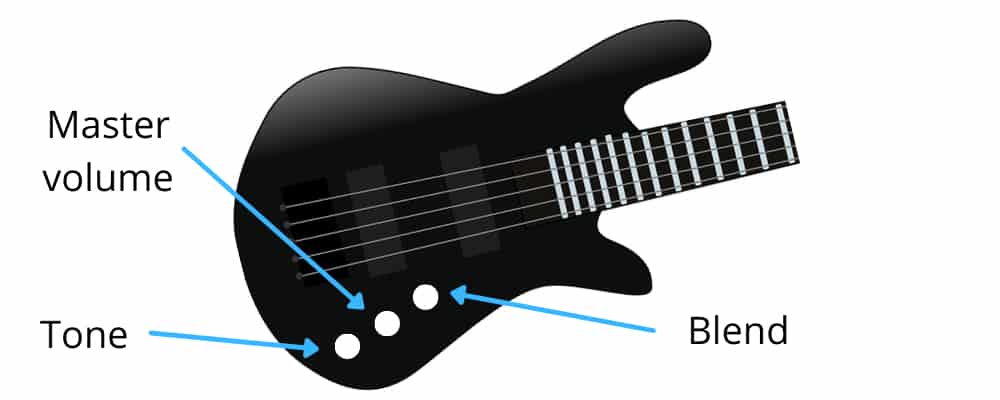
Two Pickups and Four Controls
Bass guitars with two pickups and four knobs usually have a master volume control, blend control (to adjust the emphasis of the bridge or neck pickup), bass control and treble control.
Bass guitars with this layout include:
- Schecter Omen
- Schecter Johnny Christ
- Ibanez SRMD200
- Warwick GPS Corvette
Usually the master volume and blend controls are closer to the centre, and the EQ controls (bass and treble) are on the edge of the guitar. You can identify the volume pickup easily, and the blend pickup will often be next to it.
Identifying the blend and EQ controls:
- Set all the controls to midway, except for the volume (turn this on full).
- Turn one of the controls to maximum and tap each pickup lightly using a screw driver. If only one pickup produces sound, then this is the blend control.
- The bass control will be the remaining control that adjusts how “boomy” the sound is.
- The treble control will be the remaining control that adjusts how harsh and crisp the tone is.
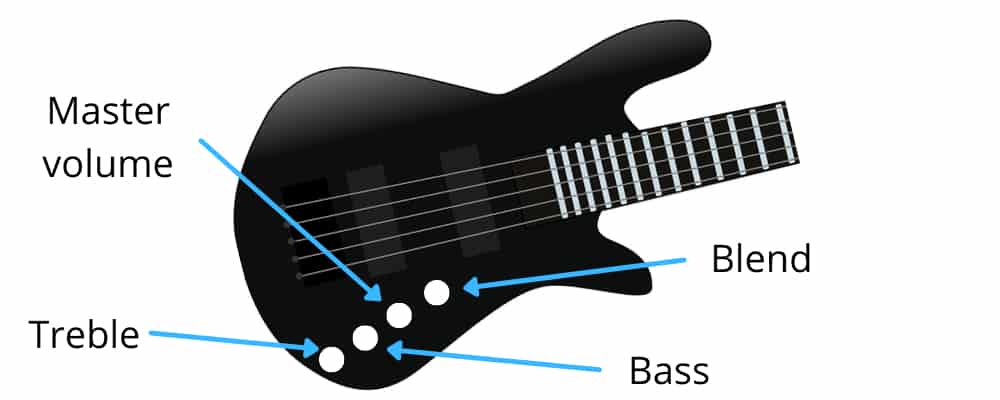
Two Pickups and Five Controls
The two pickup and five control layout is one of the most popular on bass guitars. Here’s what they usually are:
- Master volume
- Blend
- Bass
- Mids
- Treble
Often, the master volume and blend controls are closest to the centre, whilst the EQ are the outer controls and usually go in order of bass > mids > treble (centre to outer of the bass guitar).
Here’s how to check.
Identify the volume control:
- Make sure your bass is connected to your amp.
- Turn all the controls on your bass to zero.
- Turn the first control up to see if it is a volume control. You can tap on the pickup very lightly with a screw driver to see if it picks up any sound.
- Repeat this with the other controls if the first one is not the volume control.
Identify the blend control:
- Set all the controls to midway, except for the volume (turn this on full).
- Turn one of the controls to maximum and tap each pickup lightly using a screw driver. If only one pickup produces sound, then this is the blend control.
Identifying the EQ controls:
- Set all the volume to full and the rest of the controls to the centre.
- The bass control will be the remaining control that adjusts how “boomy” the sound is.
- Turning the mids control down will cause the tone to sound thinner.
- Turning the treble control up, will create a harsher tone and may cause the bass guitar to hiss and be very sensitive if you touch any strings lightly.
Bass guitars with two pickups and five controls include:
- Schecter Riot
- Ibanez SR370E
- Ibanez SR2/ SRM
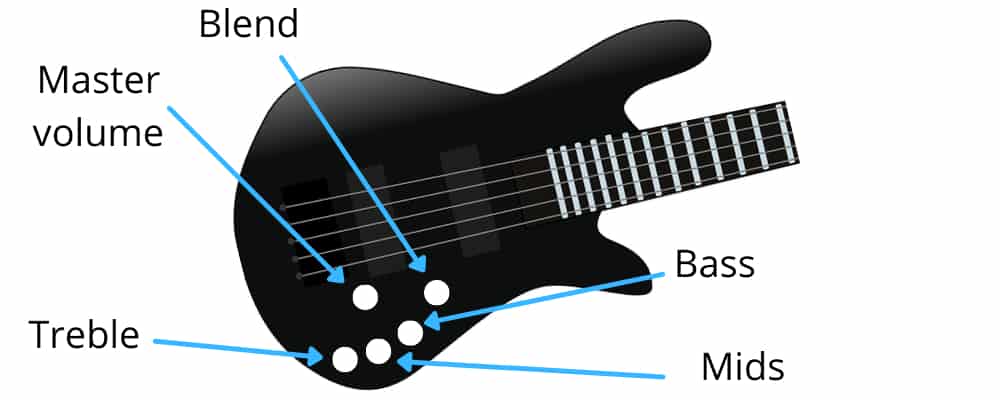
Three Pickups
It’s quite rare, but some bass guitars have three pickups. Instead of having a blend control, they will usually have a 3 or 5 way pickup selector allowing you to activate either bridge, neck or middle pickup in isolation, or mix the bridge/ middle or neck/middle pickups. They will also usually have a master tone and master volume control. Some may have a master volume control and 3 more knobs to adjust the bass, mids and treble.
Additional Controls
Some bass guitars may have additional controls:
- Coil split/ tap: this can be found on some bass’ with humbuckers. It allows you to split the humbucker so it sounds more like a single coil pickup (thinner and brighter)
- Power Switch: this is often seen on active bass guitars to allow you to switch from passive to active mode.
Here are some more articles you might find useful:
